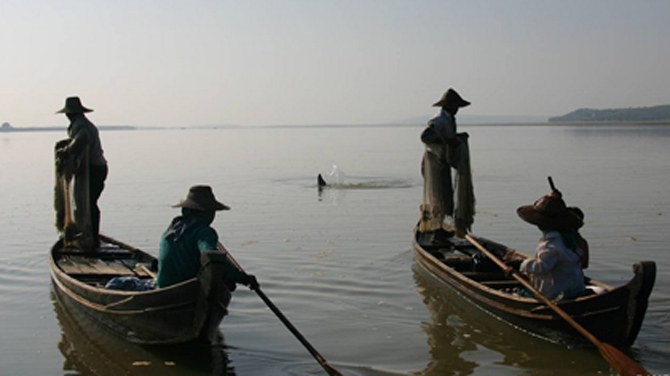Irrawaddy Dolphins are Firm Fisherman’s Friends

When nature lovers talk about the Irrawaddy River, the lifeblood of Burma, descriptions focus on her majestic beauty, breathtaking scenery as well as the unique history and culture born over the centuries.
However, these days it is the tale of the admirable Irrawaddy dolphins, named after the waterway, which captures the imagination most of all.
These graceful swimmers are closely related to the orca (killer whale) with a large, rounded forehead and snub beak. Their gray bodies darken towards slate blue while their abdomens remain a slightly paler shade.
They are commonly seen in groups fewer than six, occasionally emerging for low leaps above the surface but never riding around the bow of passing vessels like their ocean-dwelling cousins.
Unlike dolphins from other Southeast Asian countries—such as Laos, Cambodia, Indonesia, the Philippines, Thailand, Bangladesh and India—the Irrawaddy variety of Burma is famous for helping local fishermen.
These adorable creatures communicate with each other through clicks, creaks and buzzes which are thought by marine biologists to be a way of determining their location using a dominant frequency
"When the fishermen trace the dolphins, they tap on the side of their small boats with a wooden staff to make a rhythmic call. Later, they softly rustle the water with the oar, winding clockwise and anti-clockwise, and frequently combining this sound with the staff.
“The first taping is to notify them that we are here,” a fisherman of Singu Township told The Irrawaddy. “Sometimes they don’t know whether this is their friend or their enemy. So the rustling sound is to convince them that we are not their enemies and to say, 'let’s catch fish together!'”
However, this signaling method is not a sure-fire way of persuading dolphins to lend their assistance. “There are times when we return without any sign of them. Sometimes only one is seen, but sometimes two or three dolphins are spotted,” he said.
After a while, two Irrawaddy dolphins arrive in the distance to assess the situation. Before too long, they swim to-and-fro in a semi-circle, herding a school of fish toward the boat. Increasingly intense splashing from their prey can be seen as the herd is forced into a tighter group.
As the circle decreases, one of the dolphin lingers outside to act as a sentry in case any individual attempts to flee the school. Meanwhile, the fishermen prepare to cast their nets while waiting for a “fluke wave”—a dolphin waggling its tail fins back and forth above the water—to indicate they have herded enough fish to catch.
The fishermen give a tapping sound to signal that they are ready to throw the net, and the dolphins make a quick final push of the school toward the boat. As soon as the fisherman throws the net the dolphins rush out of area to prevent getting trapped inside themselves.
As the teeming catch is hauled on board, the dolphins move back toward the boat and wait on the surface for their quota to be thrown by the fishermen. Sometimes, they also hoover up escapees from the net.
After all the catch has been securely stored, a fisherman taps the side of the boat again and the dolphins swim closer like they are awaiting orders. When the fisherman slaps the water with his oar, telling his aquatic colleagues to be ready for a second cast, the dolphins make a guttural sound from their throat to show they understand, and break off from each other to start the whole routine once again.
“If we get enough fish we signal them by tapping differently and they understand,” said a fisherman. “We feed them some fish and if they are full, they just swim around, to-and-fro, making sounds, sometimes shooting a stream of water like they are saying goodbye, and then dive into the river and disappear.”
According to local fishermen, working with the dolphins can triple their catch compared with laboring on their own. And this traditional understanding between man and beast has been handed over from generation to generation of Irrawaddy fishermen.
The area between the Kyauk Myaung and Mingun sections of the Irrawaddy River, in Mandalay Division, measures around 230 miles (370 km) of freshwater where Irrawaddy dolphins can be found, and has been established as a protection zone for the creatures since 2005.
According to the New York-based Wildlife Conservation Society (WCS)—which jointly works with Burma’s Department of Fisheries for the preservation of Irrawaddy dolphins—the population found around Kyauk Myaung has increased to 86, including many calves.
There were only 37 found along the river in 2003, which increased to 72 by late 2008.
1 | 2 next page »
|
||
|
||
|
||
|
||
|
||
|
||
|
||
|
||
|
||
|
||
- Students Without a University
- Displaced and Distressed
- Training the Next Generation of Kachin Rebels
- Rangoon Art Show Provides Arresting Display
- Magical Mandalay Still Holds Court for Tourists
- Distrust and Displacement on Kachin Frontline
- Thein Sein: Reformist or Caretaker?
- School’s Not Out in Kachin State
- Thein Sein: Reformist or Caretaker?
- For Rangoon Strikers, No End in Sight
